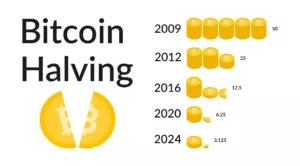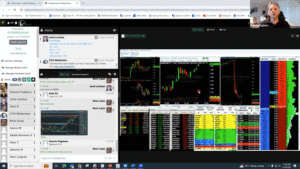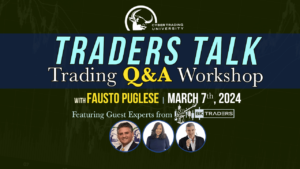It is a widely recognized fact that a majority of traders struggle to generate profits over an extended period of time. This can be attributed to various factors, including preventable amateur trading errors. However, even experienced traders can fall prey to a common pitfall: selecting the wrong asset to trade.
Many traders approach trading by pre-determining which asset they want to trade, such as a specific futures contract or stock. Unfortunately, this approach often leads to poor performance or outright losses because any given asset trades in a trendless, random manner approximately 70 percent of the time.
As a result, a trader who selects a specific asset to trade ahead of time has a 7 out of 10 chance of encountering "whipsaw" moves that generate commission costs and lead to frequent small losses. This can ultimately result in significant losses over time, commonly known as "death by a thousand cuts."
To address this issue, I have developed a system as part of my intraday stock trading method, which focuses on identifying stocks that are most likely to trend rather than chop around, thereby improving the "signal-to-noise ratio" in the stocks I trade.
To identify the best stocks to trade each day, I use eight rules that form the basis of my system.
Only Trade Trending Stocks
To avoid the trendless, random chop that characterizes most assets on a daily basis, traders must identify stocks that have a high likelihood of making significant moves on the day they intend to trade them. The key to achieving this is by selecting stocks that have already experienced a large move.
The rationale behind this is that stocks that have made a significant intraday move early in the day are likely to have sufficient momentum left for traders to ride profitably. To identify these stocks, I typically look for the largest percentage gainers and losers on the Nasdaq in pre-market trading. Most direct-access brokerage platforms provide screening tools to enable traders to locate these big movers.
A stock that has experienced a substantial move in pre-market trading is highly likely to trend strongly after the market opens at 9:30 am. Many of these stocks have had significant earnings releases, important news, or FDA approvals or rejections, especially in the case of biotech stocks. Such news can trigger active trading and create intraday trends that are favorable for profitable trading.
Stay away from stocks that are over $30 per share.
As a trader, I tend to avoid pricier stocks as they tend to belong to larger companies that are less volatile. This is because larger companies tend to have a more established market presence and their stock trends may not be as profitable.
In contrast, smaller biotech stocks, for example, are often more volatile and may make larger moves on average compared to blue-chip stocks such as Microsoft. This increased volatility can create more opportunities for traders to capture profitable trades by exploiting intraday trends.
Therefore, my focus is on identifying and trading stocks with the potential for large intraday moves, regardless of their current price point. By focusing on stocks that have a higher probability of trending, rather than those with established market positions, I can potentially capitalize on the increased volatility and generate higher profits.
Avoid Brand Name Stocks
In addition to avoiding pricier stocks, I also tend to steer clear of well-known stocks such as Apple or Intel. This is because these stocks are often dominated by highly skilled professional traders from renowned institutions like Goldman Sachs and JP Morgan. As a result, independent traders may find it more challenging to compete against these institutional traders.
In contrast, smaller stocks tend to receive less attention from institutional traders, as they are more challenging to move large amounts of capital in and out of. This allows skilled independent traders to have a better "edge" compared to trading in well-known stocks.
By focusing on smaller, less well-known stocks, I can potentially exploit inefficiencies in the market and take advantage of profitable intraday trends. While these stocks may carry higher risks, the potential for higher profits is also greater, making them an attractive proposition for experienced traders.
Avoid stocks with insufficient trading depth
To minimize the risk of sudden trading losses, I focus my trading strategy on smaller stocks where I have an edge. At the same time, I avoid stocks that are too thinly-traded or illiquid, as these stocks can trade in an erratic manner that can lead to unexpected losses.
To ensure that I am trading in stocks that are not too thinly-traded or illiquid, I check the Nasdaq Level II book for each stock. This allows me to see the number of market makers or ECNs on both the bid and ask sides of the book just above and below the current stock price.
Ideally, I want to see a decent number of market makers or ECNs, and at least a few hundred shares offered by each major market maker or ECN at each of the key price levels above and below the current stock price. This information helps me to identify stocks that are likely to have enough liquidity to support my trading strategy without experiencing erratic price movements.
Steer clear of stocks with low trading volumes
Building on the previous point, I focus on trading stocks that have a large enough trading volume to support smooth trading execution. This means that I am looking for stocks that have a high trading volume, as this indicates that there are enough buyers and sellers in the market to facilitate smooth trading without causing erratic price movements.
When a stock has a high trading volume, I can enter and exit my trades quickly and efficiently, without having to worry about sudden price swings that can occur when trading stocks with lower trading volumes. This helps me to manage my risk and avoid unexpected losses.
Avoid stocks with very high trading volumes
In addition to focusing on stocks with sufficient liquidity, I also avoid trading stocks with very high trading volumes. While high trading volume can indicate strong market interest in a stock, it can also mean that the stock is dominated by larger, brand name companies that I try to avoid trading.
Stocks that are included in the Nasdaq 100 index and/or trade over 25,000,000 shares on a typical day tend to be the largest and most widely followed stocks in the market. As such, they are often dominated by institutional investors and professional traders, making it more difficult for independent traders like myself to find an edge in the market.
By avoiding these high-volume stocks, I am able to focus on smaller stocks that are more likely to exhibit the types of intraday trends that I look for in my trading strategy. This allows me to more effectively identify and capitalize on profitable trading opportunities, while minimizing my exposure to the risks associated with trading in heavily dominated markets.
Be wary of stocks with large bid-ask spreads
A bid-ask spread is the difference between the highest price a buyer is willing to pay for a stock (bid) and the lowest price a seller is willing to accept for the same stock (ask). A narrow bid-ask spread means that there is little difference between the highest price a buyer is willing to pay and the lowest price a seller is willing to accept, indicating that there is a high level of liquidity and trading activity for that stock.
In trading, a narrow bid-ask spread is desirable because it ensures that the stock is trading in a smooth and efficient manner, with little or no volatility caused by sudden price swings. Therefore, to ensure that I'm trading stocks that are not only liquid but also trading in a smooth and efficient manner, I prefer to trade stocks that have a maximum bid-ask spread of $0.06, but stocks with spreads of $0.02 to $0.04 are even better. This helps me to ensure that I can enter and exit my trades as quickly as possible a
Watch out for market maker traps
You should be cautious when trading stocks that have a significant imbalance between market makers and ECNs on either the bid or ask side of the Nasdaq Total View. An imbalance occurs when there are many more shares being offered than bid, or vice versa. In this case, the stock may have a bullish or bearish bias. For example, if there are more shares being offered than bid, the stock is likely to have a bearish bias, which means that sellers are more aggressive than buyers. In this scenario, you should think twice before buying the stock as a day-trade. Conversely, if there are more shares being bid than offered, the stock is likely to have a bullish bias, which means that buyers are more aggressive than sellers. In this scenario, you should think twice before shorting the stock as a day-trade.
Conclusion
To summarize, having a well-defined set of rules and a clear trading strategy can go a long way in reducing risk and improving one's chances of success in the markets. It's commendable that you are offering trading courses to help others enhance their skills and knowledge in this area. By sharing your expertise and insights, you can empower aspiring traders to make informed decisions and achieve their trading goals.I discuss these methods, my approach to entries and exits, advanced Nasdaq TotalView and ECN Book, and much more in all of my trading courses.



